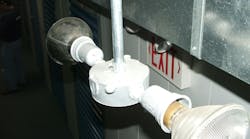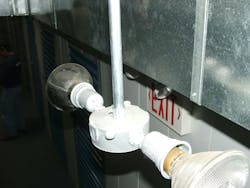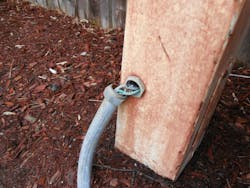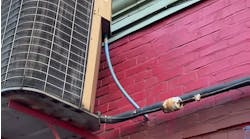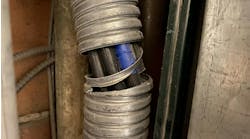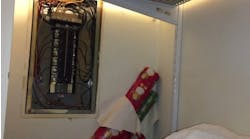All references are based on the 2023 edition of the NEC.
A Prohibited Pendulum
I spotted this “pendulum of doom” hanging above my head while working in the corridor of a storage facility. I positioned myself on a step ladder to take this photo and get a better view.
Electrical metallic tubing (EMT) is not permitted to be used for support of boxes or luminaires. If the set screw of the connector becomes loose, the box and luminaires could come crashing to the floor and potentially cause injury to anyone below. That EMT connector is the only thing holding that box up.
Section 358.12(2) prohibits using EMT for the support of luminaires or other equipment except conduit bodies that are no larger than the trade size of the tubing. This storage facility had several other installations that were done the same way as the one in this photo. All of them are Code violations and need to be done over in a manner that would be safe and Code compliant. Sections 314.23(A) through (H) provide many options for supporting boxes in Code-compliant ways, but none of them includes using EMT or EMT connectors as the supporting means for boxes. Perhaps some threaded rod could be added here for supporting the box.
Snap, Crackle, Pop Goes the Connector
I’m guessing this installation was probably once Code compliant, but with that EMT connector snapped off, some serious problems have arisen. Is that EMT raceway or the light pole properly bonded now? Or are these items at risk of becoming energized and presenting a shock hazard with no way to clear a ground fault?
The conductors have definitely been damaged by the jagged edges of that broken connector, which greatly increases the shock risk. Section 300.10 requires metal raceways and metal enclosures for conductors to be metallically joined together to provide effective electrical continuity. Section 250.4(A)(3) requires these metal parts to be connected together and to the supply source in a manner that creates an effective ground-fault current path. Section 110.12(B) prohibits damaged or broken parts that adversely affect the safe operation or mechanical strength of the equipment. Section 358.12(1) prohibits using EMT where it is subject to severe physical damage. When we put all these rules together, we can see there are many concerns with the present state of this installation, and repairs need to be made here before someone gets shocked.
